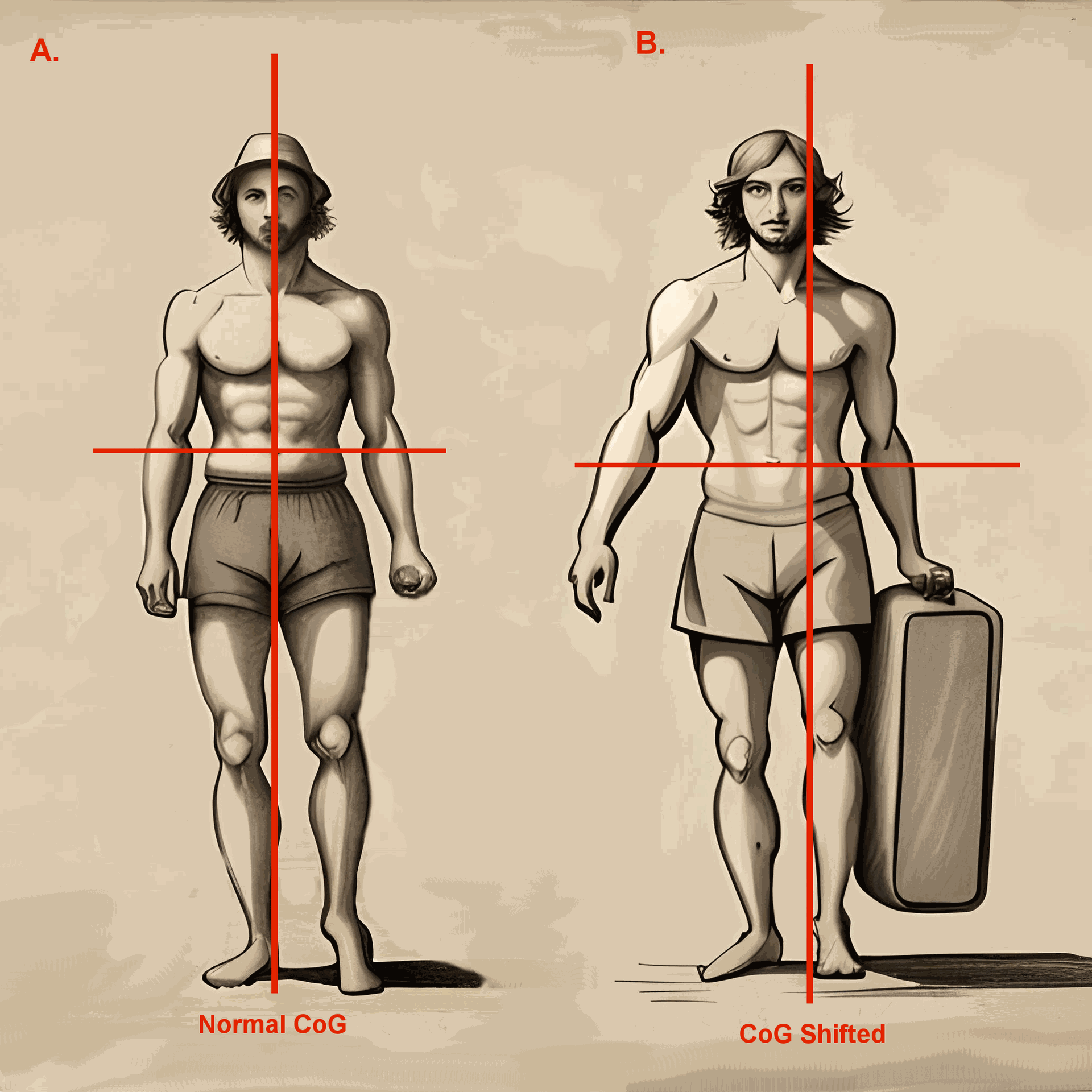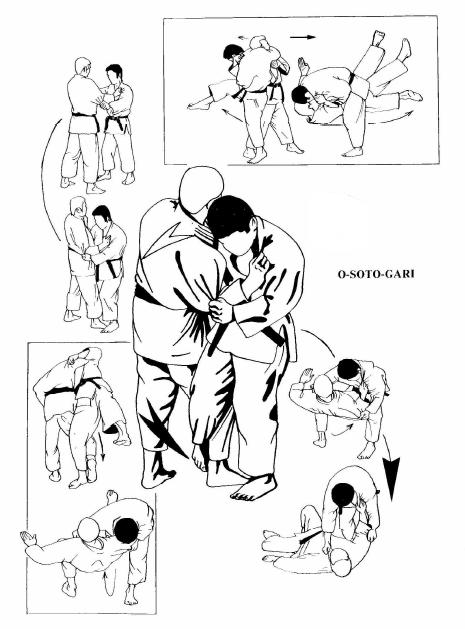What is the Centre of Gravity
Each body is made of mass, the central point where all mass is equally balanced is known as the centre of mass.
When we apply Newton’s second law, force equals mass multiplied by acceleration (F=ma), to the centre of mass it is now referred to as the centre of gravity (CoG).
The CoG is the pivot around which the sum of all torques produced by the weight of a body’s segments equals zero and is balanced in all directions (Hall 2019). See figure 1 A.
This can be further demonstrated by the exercise, unilateral farmers walk. When additional mass is added to one side of the body, gravity takes affect and begins to accelerate the additional mass towards the planets centre.
"Athletes who partake in grappling combat sports have greater dynamic balance in order to maintain their CoG while simultaneously manipulating and disrupting their opponent to score a successful throw"
This shifts the CoG toward the side of greater mass by generating a torque. See figure 1 B.
In order to overcome this torque, most individuals will move the opposite arm outwards from the body to generate torque in the opposite direction.
If this is not enough to generate an equal and opposite torque to the additional mass, an individual must then engage their core muscles. This action generates the remaining torque required to balance the forces and correct their CoG.
Having a strong core is crucial to effectively correct and control ones CoG, both for athletic performance and injury prevention. Taylor and Reed (2020) advise that the unilateral farmers walk is one of the most effective exercises for developing core strength.
Figure 1.
Centre of gravity changes.

How do Athletes Manipulate the Centre of Gravity
When it comes to athletes manipulating the CoG there are two prime ways in which they can do this.
- Either changing the size of the base of support (BoS)
- Or changing the position of the CoG.
They can further manipulate their own CoG and BoS, or that of another object or opponent.
Centre of Gravity for Weight Lifting
Research conducted by Mastalerz et al. (2019) investigated the difference between successful and unsuccessful snatch attempts by elite female weightlifters.
Using digital cameras and the Ariel Performance Analysis System, they monitored the barbell path and 17 points on the athlete’s body.
During the snatch, an athlete is required to accelerate the barbell from the ground to be caught above their head.
Firstly, the athlete must manipulate the barbell’s CoG to turn it into a projectile with a flight path ideal for successfully executing the movement.
Second, the athlete must rapidly accelerate their own CoG downwards so that it is lower than the barbell’s CoG.
Finally, they must widen their BoS to assist with obtaining a lower CoG, and increasing their stability for receiving the barbell’s mass once gravity takes effect.
Mastalerz et al. (2019) discovered statistical differences in knee and hip angles in preparation for the aerial phase, as well as the athletes CoG velocity, indicating that a successful snatch requires correct CoG and BoS manipulation.
Centre of Gravity for Grappling
Grappling combat sports such as Judo, Sumo, and Wrestling are a constant battle between two combatants attempting to disrupt one another’s CoG and BoS, while maintaining their own.
A study by Maśliński et al. (2016) investigated the static and dynamic body balance of judokas at varying ages and experience levels.
Maśliński et al. (2016) discovered that the dynamic balance of judokas improves with age and experience. Leading to the conclusion that the nature of the sport which involves constant motion and changing of the athlete’s body position trains their ability to maintain balance and stability by manipulating their CoG and BoS.
Dhaka & Hooda (2019) used Kinovea software to analyse O-Soto-Gari throwing technique to assess the location of Tori (thrower) and Uke’s (throw receiver) CoG.
Dhaka & Hooda (2019) analysed how Tori’s CoG is applied to Uke’s body transferring weight from one object to another. Tori continues to apply force to move their combined CoG outside of Uke’s BoS.

Tori then prevents Uke from adjusting their BoS by attacking Uke’s legs with their own, causing Uke to rotate around their CoG landing prone on the ground.
Demonstrating that a successful throw requires manipulation of Tori’s and Uke’s CoG and BoS simultaneously.
Conclusion
In order to achieve success in their sports, athletes need the ability to accurately manipulate their own CoG and BoS.
This can be seen in weightlifting where the need to rapidly lower ones CoG under a barbell is crucial for a successful snatch (Mastalerz et al., 2019).
It has also been demonstrated how athletes who partake in grappling combat sports have greater dynamic balance (Maśliński et al., 2016) in order to maintain their CoG while simultaneously manipulating it and disrupting their opponent CoG and BoS in order to score a successful throw (Dhaka & Hooda, 2019).
References
Dhaka, D., & Hooda, R. (2019). Implementing Biomechanics to Study Motions of Judokas through Kinovea Software for Enhancing their Performance & maintaining Center of Gravity during Throwing Techniques. International Journal of Engineering and Advanced Technology, 8(5), 1607-1613. issn. 2249-8958
Hall, S. (2019). Basic biomechanics (Eighth ed.). McGraw-Hill Higher Education.
Maśliński, J., Witkowski, K., Cieśliński, W., & Śliz, T. (2016). Body balance in judokas. Journal of Combat Sports & Martial Arts, 7(1), 43–49. https://doi.org/10.5604/20815735.1222834
Mastalerz, A., Szyszka, P., Grantham, W., & Sadowski, J. (2019). Biomechanical Analysis of Successful and Unsuccessful Snatch Lifts in Elite Female Weightlifters. Journal of Human Kinetics, 68(1), 69–79. issn.1640-5544
Taylor, J., & Reed, M. (2020). Increase Hip and Trunk Stability with Loaded Carries for Injury Prevention, Rehabilitation, and Performance. NCSA Coach, 7(3), 50-54. https://www.nsca.com/education/articles/nsca-coach/increase-hip-and-trunk-stability-with-loaded-carries/